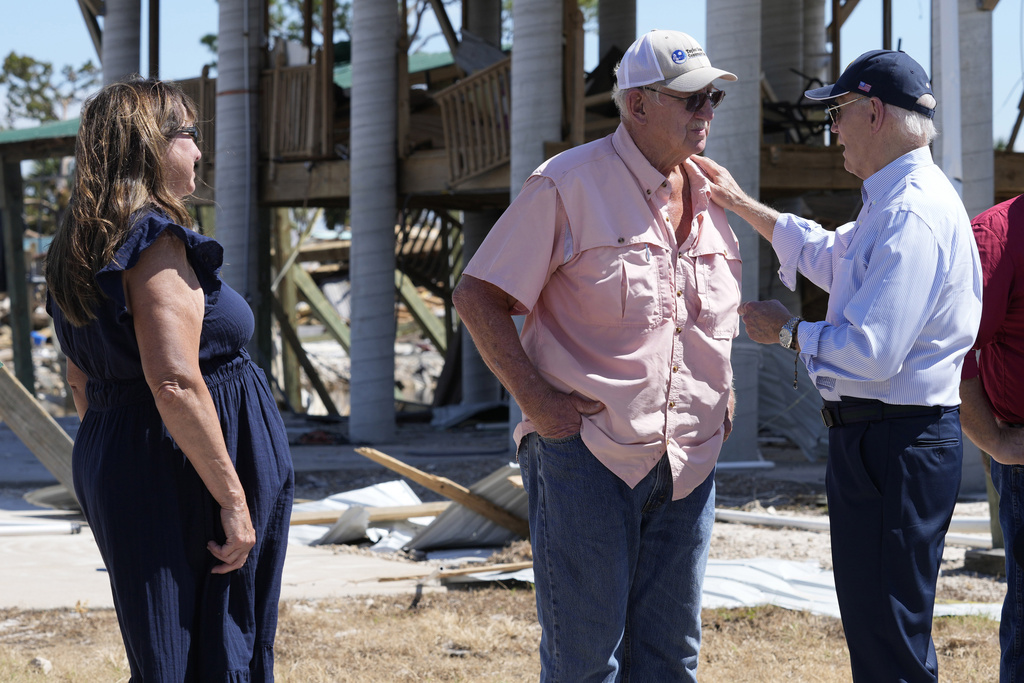Biden Seeks $100B Disaster Aid After Hurricanes Helene, Milton \ Newslooks \ Washington DC \ Mary Sidiqi \ Evening Edition \ President Joe Biden has requested nearly $100 billion in emergency aid to assist recovery from Hurricanes Helene, Milton, and other disasters. The funds aim to support FEMA, farmers, infrastructure repairs, housing, and long-term mitigation efforts. Biden urges swift Congressional action to meet urgent recovery needs and prevent further setbacks.

Biden’s $100B Disaster Relief: Quick Looks
- Request Overview: Nearly $100 billion requested to address disaster recovery needs.
- FEMA Relief Fund: $40 billion allocated to prevent budget shortfalls.
- Agricultural Support: $24 billion for farmers suffering crop and livestock losses.
- Community Development: $12 billion for housing and urban grants via HUD.
- Infrastructure Rebuilding: $8 billion for highways and bridges in over 40 states.
- Water System Upgrades: $4 billion allocated for long-term disaster resilience.
- Historical Context: Biden cites past disaster aid allocations after Katrina and Sandy.
- Congressional Action: Urgency expressed to finalize aid during the lame-duck session.
Deep Look
The request, issued during a critical lame-duck session, comes as lawmakers face a packed legislative agenda before the incoming Congress and administration take over. Biden stressed the need for decisive action, drawing on his personal visits to disaster-hit areas where he witnessed the destruction and spoke directly with residents and business owners.
Breakdown of the $100 Billion Proposal
FEMA Disaster Relief Fund
Agricultural Assistance
The proposal includes $24 billion to support farmers and ranchers who have suffered significant losses due to the storms. From destroyed crops to livestock losses, this funding aims to stabilize rural communities and ensure the agriculture sector can recover swiftly from the impact of natural disasters.
Housing and Urban Development Grants
An additional $12 billion is earmarked for community development block grants administered by the Department of Housing and Urban Development (HUD). These funds will support housing repairs, urban redevelopment, and essential services in disaster-affected areas, ensuring residents can rebuild their homes and communities.
Infrastructure Repairs
Water System Upgrades
The plan includes $4 billion to upgrade and strengthen water systems, helping communities build resilience against future natural disasters. Investments in water infrastructure are intended to prevent damage from flooding, ensure access to clean water, and improve overall disaster preparedness.
Urgency of Congressional Action
Biden’s appeal urges Congress to act quickly, drawing parallels to past large-scale disaster relief efforts. He cited the $90 billion provided for Hurricane Katrina in 2005 and the $50 billion allocated for Hurricane Sandy recovery in 2013. The president emphasized that the same level of urgency and commitment is necessary today to address the damage from Hurricanes Helene and Milton and support communities still recovering from earlier disasters.
Legislative Process and Outlook
House Speaker Mike Johnson, a Republican from Louisiana, expressed Congress’s intent to carefully review the request and deliver aid to hurricane-affected communities. The Senate Appropriations Committee will hold hearings on Wednesday to hear from federal agency leaders about the proposed funding distribution.
One potential avenue for securing the aid is attaching it to a government spending bill. With federal agency funding set to expire on December 20, lawmakers may combine the disaster aid package with a broader spending bill to ensure swift passage.
Historical Context of Federal Disaster Aid
The scale of the request is not unprecedented. Following Hurricane Katrina in 2005, Congress approved over $90 billion in disaster relief, while Hurricane Sandy in 2013 prompted a $50 billion aid package. These comparisons serve to reinforce Biden’s argument for decisive and immediate Congressional action.
The appeal resonates with both the immediacy of recent disasters and the long-term necessity of preparing for future storms, floods, and other natural calamities. Biden’s proposal, if approved, would provide essential support to families, farmers, and businesses, while reinforcing critical infrastructure across the country.
Biden Seeks Biden Seeks Biden Seeks







